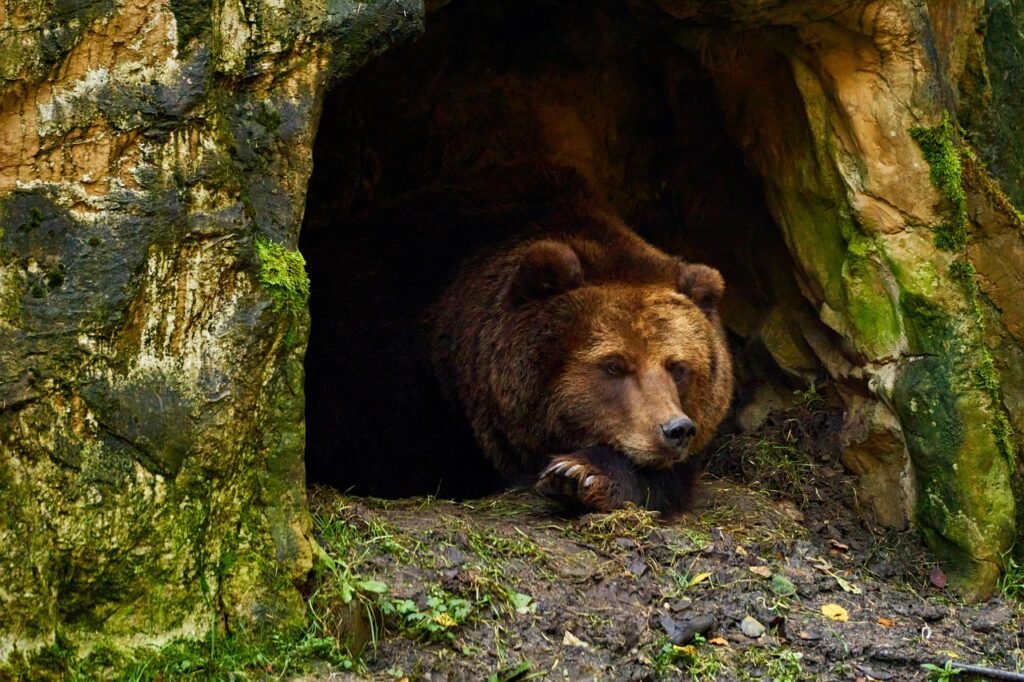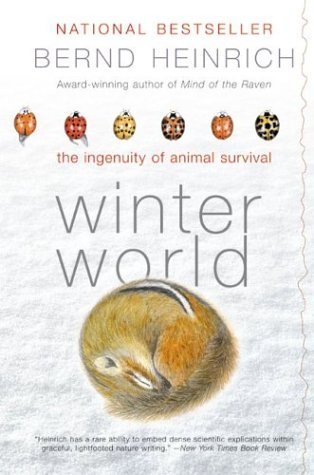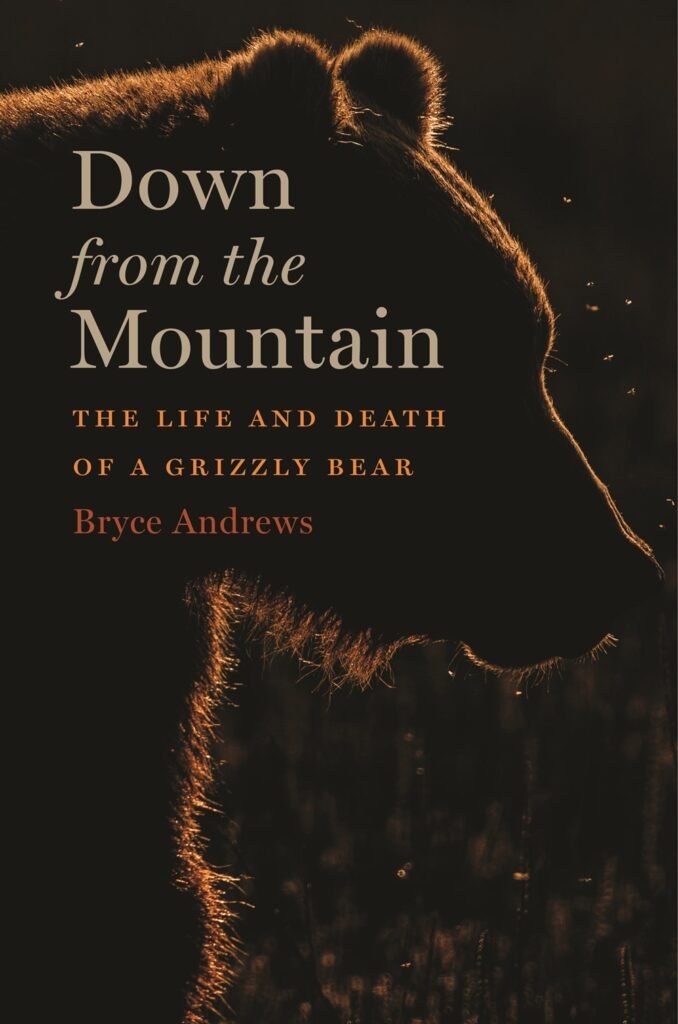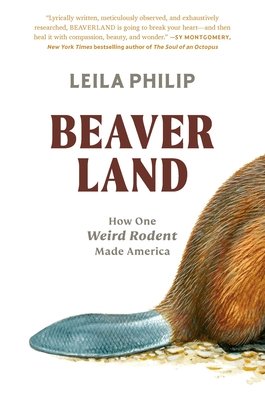by Public Service Associate Autumn

All living things adapt to the onset of winter.1 Birds tend to migrate.2 Foxes, hares, bison and plenty of other animals grow thicker, denser coats, often in cooler, more winter-camouflaged colors. Humans bundle up in thick winter coats and gloves and complain about having to preheat their cars in the morning. Some creatures like bears, however, hibernate.
I must admit, I’ve always envied bears a little bit. Who doesn’t want to spend the entire winter asleep in a nice cozy den, warm and unconcerned about the world outside, especially when the alternative is having to brave the cold and the snow and bad drivers to get to work? Hibernation begins to sound great right about then. Humans, alas, do not hibernate,3 but perhaps that’s for the best! It turns out that hibernation, for bears and most other hibernators, is not as lovely as one might imagine.
Before we can jump into the fascinating world of hibernation, we must first know a little more about it. Hibernation is loosely defined as “the condition or period of an animal or plant spending the winter in a dormant state.”4 I note loosely here because the definition has expanded with time.5 Though you might think that the chill of winter is one of the defining features of hibernation, it is actually the lack of food and not the cold itself that forces animals to hide away through the freezing months. The cold does have an impact on this, however, as lower temperatures require a higher metabolic output for animals. If you cannot find or hide enough food to maintain your body heat through the winter, hibernation is a good alternative.
This simplicity does not, however, mean that hibernation is easy. The simple act of not moving for long periods of time comes with its own problems, the most severe of which is muscle wasting and loss of bone mass.6 This trade-off explains why hibernation is an alternative means of surviving the winter and not the norm. Even related species may have different tactics for surviving the winter. Ground squirrels, for example, tend to hibernate, where tree squirrels do not. Even the act of hibernation itself is highly variable, with every hibernating animal having different tricks to get by.
Usually when people think of hibernation, they think of bears. Hilariously, though, the fact that bears hibernate at all is sort of strange! Bears are the only large mammals to hibernate. Unlike small hibernators, who have a hard time maintaining enough mass to keep their body temperature high enough when the temperature drops, bears should be able to be awake through the winter just fine. However, their diet, made mostly of berries, grain, fish and insects, with less than five percent of their food coming from hunted or scavenged meat, prevents them from finding adequate food through the winter. Instead, they, along with a few other mammals like groundhogs,7 have to rely on getting enough food in the fall to have the fat stores to get through winter. Once huddled down into their den, bears will remain almost completely still, only moving every few days to roll over.8

You would think that their body temperature would drop significantly from the lack of movement, but they manage to maintain a high, stable body temperature. They also manage to maintain the integrity of their bones and muscles, combating the other downside of hibernation in ways that scientists haven’t quite figured out yet. We know that they combat bone loss by turning off the genes that break down their bones over the winter and then turning them back on in the spring, but exactly how bears manage that is as yet unknown. While bears might be internally impressive through their hibernation, this activity and intrigue is all but invisible on the outside. None of the externally visible life functions other than breathing are obvious during this time. During hibernation, bears do not digest, urinate or defecate, instead plugging their gut with fibrous plants,9 which can have, ah… interesting results in the spring.
While bears might be fascinating (and fun to watch during Fat Bear Week at Katmai National Park and Preserve in Alaska), they aren’t the only interesting hibernators. Arctic ground squirrels are perhaps the most scientifically impressive. They are the largest North American ground squirrel species and they hibernate for up to eight months of the year,10 and can survive some pretty terrifying temperatures, and do so by supercooling their bodies to below freezing (about 2 degrees Celsius) for up to three weeks at a time without dying.11 Scientists know they manage to supercool12 themselves, because when blood samples are taken from arctic ground squirrels and exposed to freezing temperatures, the blood alone freezes perfectly normally. Even more interestingly, when Arctic ground squirrels do periodically emerge from torpor, they seem to be asleep but when scientists have studied the squirrels, they found that in torpor, there is no evidence of REM sleep until a day after reaching normal body temperatures. Imagine a sleep so deep that you can’t even call it sleeping!
Another ground squirrel, the thirteen striped ground squirrel, also has an impressive superpower while hibernating. They have acquired a special type of bacteria that allows them to engage in urea nitrogen recycling. What this means is that this bacterium breaks down urine and allows the squirrel access to the nitrogen in it, which is then utilized for maintaining muscles’ mass, essentially using the urine as muscle-maintaining fodder. Using this trick, they emerge in the spring with the same muscle mass as they had in the fall.
As amazing and varied as hibernation is in the animal kingdom, it is perhaps more interesting to look into what we humans are doing with all of this information that we’re gleaning from our fellow creatures. Hibernation, and other adaptations that animals use to survive the winter, are helping scientists figure out all sorts of things, including ways to improve human health, and possibly enable us to travel to other planets. …Well, at least in theory. There is some hope that, since we’re animals, too, that with enough study, hibernation and other animal adaptations, can be adapted for humanity. Learning from hibernating bears how to hold off bone loss can help older humans maintain stronger bones. Knowing how to cool people without damaging their cells can aid in certain surgeries. Hibernation itself might allow us to heal better after strokes or other major medical events, or even to travel to Mars without decimating the bodies of astronauts. We just have to figure out how to apply all of this to human biology.
…Perhaps someday, eh?
While humans cannot yet enjoy the wonders of sleeping through the winter (or at least being unconscious through the winter), we can enjoy a slew of lovely books to help us survive it. I recommend the following.
Books about neat animals:




- Of Time and Turtles by Sy Montgomery | book
- Winter World by Bernd Heinrich | book
- Down from the Mountain by Bryce Andrews | book
- Beaverland by Leila Philip | book
Really long books for people who wish they hibernated:






- Jonathan Strange and Mr. Norrell by Susanna Clarke | book
- Wanderers by Chuck Wendig | book
- The Amazing Adventures of Kavalier and Clay by Michael Chabon | book
- The Witch Elm by Tana French | book
- Shogun by James Clavell | book
- Infinite Jest by David Foster Wallace | book
1Assuming, of course, that they live somewhere where winter happens.
2About 75% of North American birds do so.
3I spent quite some time trying to find out if humans could possibly hibernate and the scientific community is divided on the topic. Some people say because humans come from warmer climates, we would never have needed to hibernate and thus do not have any of the adaptations for it. Others say that we did have hibernating ancestors, and that there are even bones of ancient humanoids showing evidence that they did hibernate. Whatever the truth, we don’t hibernate now.
4Dictionary.com
5Originally, hibernating creatures were limited to those that had a significantly lower body temperature and heart rate during hibernation. This excluded bears and all reptiles, as bears maintain a high temperature and reptiles cannot control their temperatures. As scientists learned more about animal behavior, however, the definition had to be adapted, and two other terms were also added. Reptiles that hibernate technically go into brumation, and creatures hibernating over the summer are aestivating.
6Without activity, the body stops being able to maintain muscle and bone very well. This is one of the issues facing astronauts if they live in space for too long.
7Which are, weirdly, a type of squirrel.
8https://arstechnica.com/science/2022/05/bear-hibernation-more-than-a-winters-nap/
9https://en.wikipedia.org/wiki/Fecal_plug
10Interestingly, the females begin hibernating before the males do.
11https://www.adfg.alaska.gov/index.cfm?adfg=arcticgroundsquirrel.printerfriendly
12A supercooled liquid is a liquid cooled to below 32 degrees, without solidifying or crystalizing. Such liquids tend to be highly unstable.